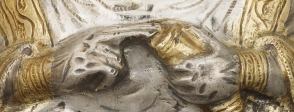Without revealing any information about the object, give students pictures of the pepper pot, for example of the front view and base view. Ask them to annotate the images first with their observations, then with their ideas about its use. This could be given as two sentences to complete “I can see…” and “I think…”. Ask them to come up with questions, what else would they like to know? What would help them figure out what the object is? Ask them to present their ideas about the object and its use, insisting that they back up their ideas with evidence.
What does the pepper pot tell us about its owner? Look at the materials it is made from; the shape and decoration; pepper, and where it came from; how the pepper pot was used; the other objects in the Hoxne hoard. Identify the mysteries - what can the pepper pot and hoard never tell us?
Look at portraits of famous British people, for example athletes, scientists, authors, musicians. Discuss their clothes, accessories, hairstyles and any objects. What can we find out about these people from their portraits? What are they telling us about themselves in their portraits? Compare these portraits with the pepper pot. What can we find out about this Roman woman from this portrait of her on the pepper pot?
Ask students to imagine they are going on a long journey and make two drawings:
Drawing 1: everything they would they would pack in one backpack to take with them on the journey.
Drawing 2: everything they would pack in a treasure box to keep safe until they return from the journey.
Ask students to compare the things they have chosen in Drawing 2 to the items found in the Hoxne hoard – see the link in For the Classroom. We do not know what the people who buried the hoard took away with them; ask students what they think the people took, and why.
Show the class other items from the Hoxne hoard, focusing on the tableware – see the link in For the Classroom. Ask students to research Roman food to discover what food and drink the wealthy people who owned these objects would have consumed with them and how the Romans ate. Students could design a menu or draw the table laid out with the feast and the tableware. See the photo of the Mildenhall Great Dish in For the Classroom.
Use a map of the world to explore the extent of the Roman empire. Look at the objects in A bigger picture and use them to identify other places the Romans had contact with. Explore what was happening in those places at this time. How do the students think the objects and raw materials moved between the Roman empire and the east?
These two enquiries focus on broader issues.
What made people in Britain feel Roman?
By looking at a map of the Roman empire, you will see that Britain was at the far edge of the empire, but some people here felt Roman. What gave people in Britain their Roman identity? Use the pepper pot to begin investigations into food, clothes, hairstyles, buildings, household objects, language and daily activities. Several of the other Object Files on the Romans will be helpful for this.
Why was the Hoxne hoard buried?
Do research to find out about other hoards buried at this time. There are several examples in the British Museum – see More information in About the object. Why would someone bury silver and gold objects like this? What do you think were they planning to do? What was happening in Roman Britain at the time? Discuss the Roman withdrawal from Britain and the Anglo-Saxon invasions.
Finally, read Roald Dahl’s story The Mildenhall Treasure (Jonathan Cape, 1999) and discuss the discovery of the Mildenhall hoard that is now in the British Museum. There are lots of writing and language opportunities arising from the idea of finding a hoard like those from Mildenhall or Hoxne.


